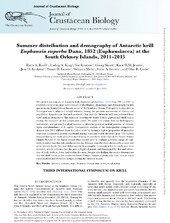| dc.contributor.author | Krafft, Bjørn Arne | |
| dc.contributor.author | Knutson, T | |
| dc.contributor.author | Krag, Ludvig Ahm | |
| dc.contributor.author | Jensen, Knut Helge | |
| dc.contributor.author | Skaret, Georg | |
| dc.contributor.author | Krakstad, Jens-Otto | |
| dc.contributor.author | Larsen, Stuart | |
| dc.contributor.author | Melle, Webjørn Raunsgård | |
| dc.contributor.author | Iversen, Svein Arnholt | |
| dc.contributor.author | Godø, Olav Rune | |
| dc.date.accessioned | 2019-02-20T17:21:39Z | |
| dc.date.available | 2019-02-20T17:21:39Z | |
| dc.date.issued | 2018-11-22 | |
| dc.Published | Krafft BA, Knutson T, Krag LA, Jensen KH, Skaret G, Krakstad J.-O., Larsen S, Melle WR, Iversen SA, Godø OR. Summer distribution and demography of Antarctic krill Euphausia superba Dana, 1852 (Euphausiacea) at the South Orkney Islands, 2011–2015. Journal of Crustacean Biology. 2018:38(6):682-688 | eng |
| dc.identifier.issn | 1937-240X | en_US |
| dc.identifier.issn | 0278-0372 | en_US |
| dc.identifier.uri | https://hdl.handle.net/1956/19126 | |
| dc.description.abstract | We carried out a survey of Antarctic krill (Euphausia superbaDana, 1850) from 2011 to 2015 to establish a long-term, time-series dataset of distribution, abundance, and demography for this species in the South Orkney Islands sector of the Southern Ocean. This species is abundant in this region and is subjected to high-intensity fishing, but previous assessments of density and population dynamics are few and outdated. Our data for Antarctic krill was collected from trawl stations along survey line transects covering the South Orkney plateau and shelf region during the summers of five consecutive years. We used concurrent data on hydrography, bathymetry, and proxies for algal biomass to describe potential spatial patterns of demography and abundance of E. superba. Comparative analysis of the demographic composition showed that 2012 differed from the other years by having a higher proportion of juveniles; otherwise a consistent pattern was found among years and within the study area. The highest biomass during the study period occurred along the northern shelf edge of the South Orkney Islands. Results of the linear mixed-effect model used to evaluate a diverse range of variables revealed that the only predictors for this hotspot were the short distance from land and great bottom depth. No clear differences in demographic composition for the study area were detected, which indicates that the area is highly dynamic and dominated by flux and advection of krill, both to, from, and within the area. Despite this finding, the results demonstrate that the shelf break on the northwest South Orkney Islands is predictable over time as a krill concentration and retention hotspot during the summer season. | en_US |
| dc.language.iso | eng | eng |
| dc.publisher | Oxford University Press | en_US |
| dc.rights | Attribution CC BY-NC | eng |
| dc.rights.uri | http://creativecommons.org/licenses/by-nc/4.0/ | eng |
| dc.subject | Fisheries | eng |
| dc.subject | maturity stage | eng |
| dc.subject | Southern Ocean | eng |
| dc.subject | time series | eng |
| dc.subject | Zooplankton | eng |
| dc.title | Summer distribution and demography of Antarctic krill Euphausia superba Dana, 1852 (Euphausiacea) at the South Orkney Islands, 2011–2015 | en_US |
| dc.type | Peer reviewed | |
| dc.type | Journal article | |
| dc.date.updated | 2018-10-02T06:07:51Z | |
| dc.description.version | publishedVersion | en_US |
| dc.rights.holder | Copyright 2018 The Authors | en_US |
| dc.identifier.doi | https://doi.org/10.1093/jcbiol/ruy061 | |
| dc.identifier.cristin | 1609196 | |
| dc.source.journal | Journal of Crustacean Biology | |

